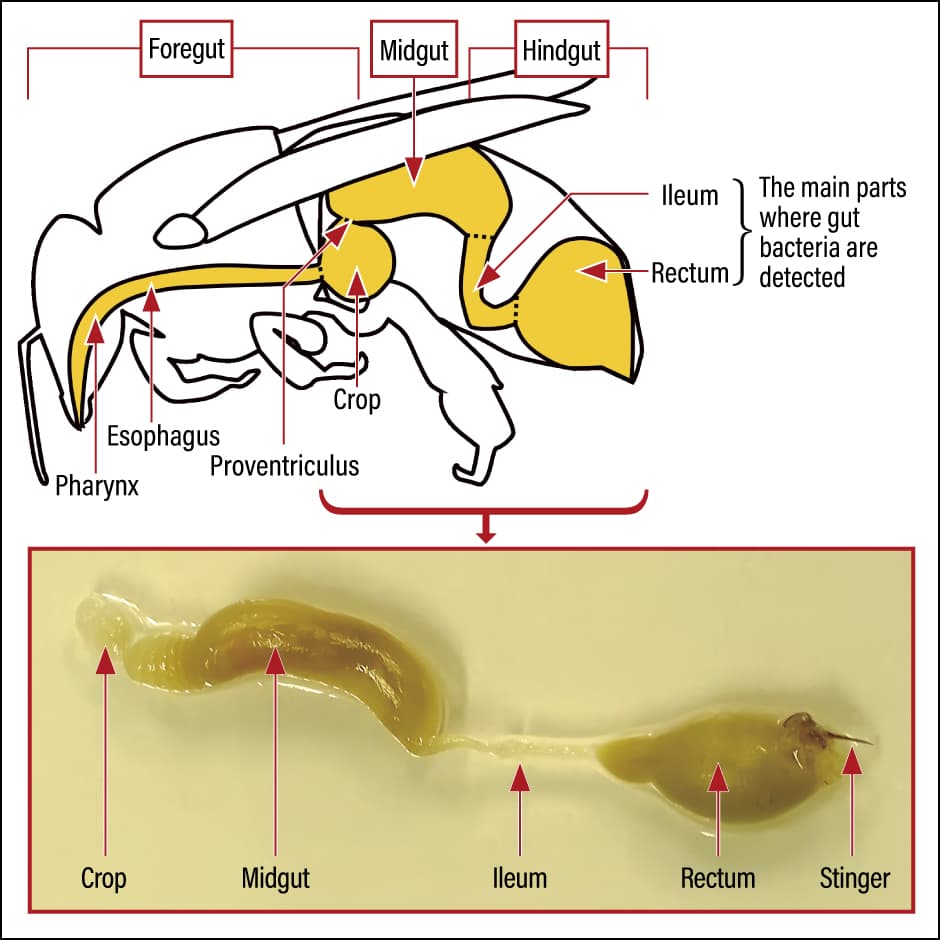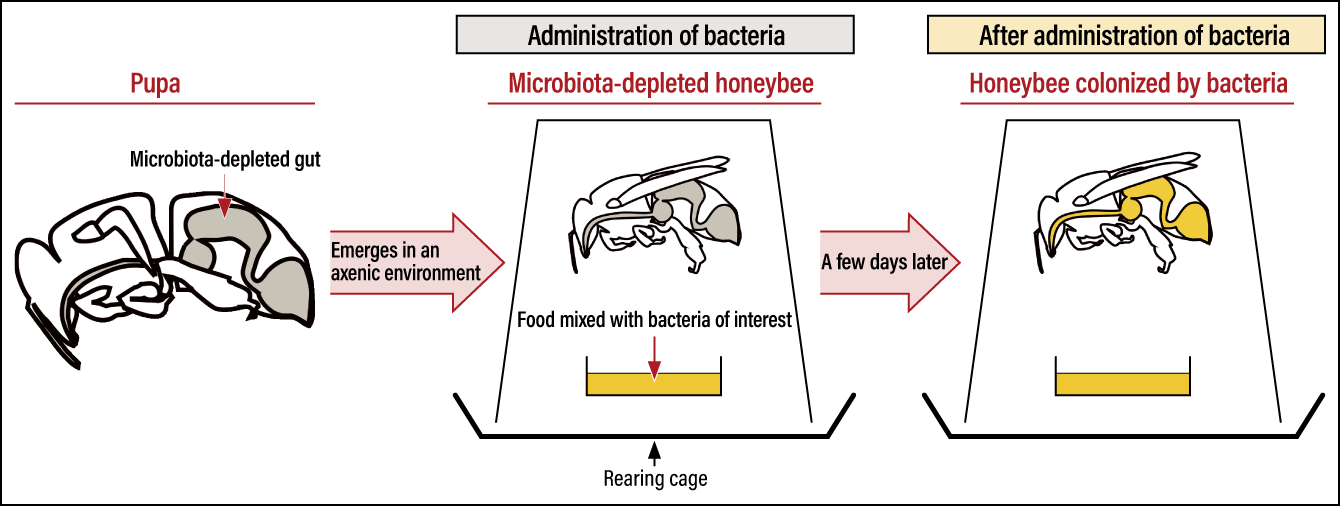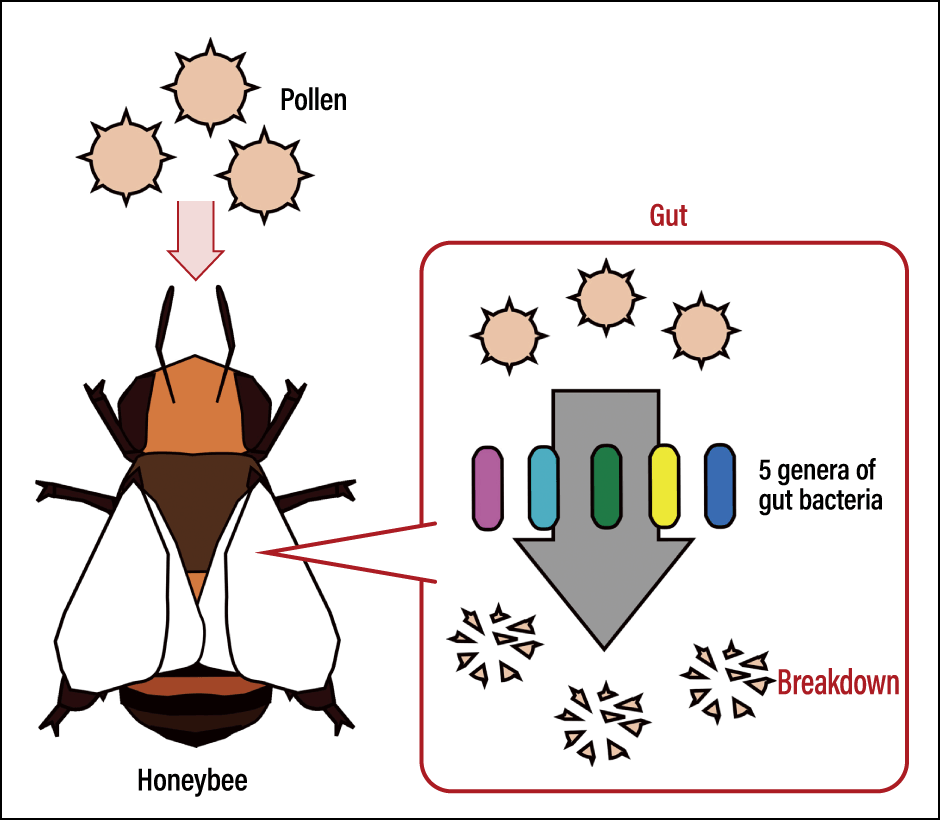Like humans, honeybees have gut microbes. However, recent studies found the gut microbiota of a honeybee has a highly distinctive feature: whereas the human gut microbiota is said to consist of 100 trillion bacteria across 1,000 species, 95% of the gut microbiota in honeybees is composed of no more than 8-10 genera of bacteria. This small number of gut bacterial species is beneficial to honeybees: for example, some of the bacteria assist in breaking down several pollen components that honeybees themselves can’t easily digest. Several studies also suggest that gut bacteria also play a role in the behavior of honeybees.
Special Feature 1 – The World of Honeybees The distinctive gut bacteria are involved in behavior and food digestion of honeybees!
composition by Toshiko Mogi
People are often a little taken aback when I tell them my research is on honeybees. But when I tell people my research in more detail, namely, that my research is about gut microbes of honeybees, they are invariably surprised. It might be because most people don’t usually imagine that honeybees have a digestive tract just like we humans, let alone that the gut of a honeybee contains microbes.
Distinctive gut bacteria of honeybees
In fact, it is not only humans and other mammals, such as mice, that have gut microbes. Microbes are found in the gastrointestinal tracts of a wide range of animals including insects, too.
Today, numerous researchers all over the world are conducting research into the gut microbes of honeybees. I am one of those researchers; my research is on the relationship between the brain and gut microbes in honeybees.
In this article, I’m going to introduce findings reported in various studies to date, along with my research.
Please note that, as most studies were conducted using European honeybee (Apis mellifera) worker bees, the word “honeybee” in this article refers to this type of bees, unless otherwise specified.
A huge number of microbes inhabit a single mammal’s gut. For example, the human gut is said to be home to 100 trillion bacteria across around 1,000 species, and the gut microbiota is known to play a part in maintaining human health and also in the onset of diseases. As you may know, the structure of human gut microbiota varies according to geography and population, and there are also differences in the structure of gut microbiota at the individual level (in other words, between two people), based on factors such as diet.
In the case of honeybees, analyses of the whole microbial community based on the nucleotide sequences have shown that bacteria belonging to no more than 8-10 genera account for around 95% of gut microbiota of a single honeybee.
In most cases, there are five genera detected from a honeybee irrespective of the colony where the honeybee is sampled: Snodgrassella, Gilliamella, Bifidobacterium, and two genera in the order Lactobacillales that are commonly known as lactic acid bacteria: Bombilactobacillus Firm-4 and Lactobacillus Firm-5. In addition to these common bacteria, there are additional three genera that are sometimes detected: Frischella, Bartonella, and Parasaccharibacter.
Why is the gut bacterial community of honeybees simple and largely consistent all over the world? This remains to be resolved.
The gut of adult bees is depleted of microbes immediately after emergence of the bees
There is another unique feature in honeybees’ gut microbiota: microbes are depleted in a honeybee gut for a while after emergence. This is because a honeybee is a holometabolous insect, which undergoes a complete metamorphosis from larva to pupa and imago (adult). Although gut microbiota is established in the larva of a honeybee, it is ejected outside the body before the larva becomes a pupa, after which the bee doesn’t eat anything until it emerges. Consequently, the gut of an adult bee is almost sterile immediately after it emerges.
As I mentioned above, the structure of honeybee gut microbiota is simple and consistent across individuals all over the world. It is possible to dissect out the gut of a honeybee and isolate the bacteria therein. Moreover, it is also possible to obtain a microbiota-depleted honeybee when a pupa is collected from the hive and maintained in an axenic condition. Accordingly, when a gut bacterium —— either alone or in combination with others —— is introduced into the microbiota-depleted honeybee, the bee provides a useful system in order to investigate the impact of a gut bacterium (or bacteria) on the host.
In studies on the relationship between gut bacteria and a host animal, the mouse is one of the most frequently-used experimental models. Although a lot of knowledge was obtained through mouse studies, mouse gut bacteria have not been fully investigated so far. It is partly due to the high diversity of the mouse gut microbiota, which consists of several hundred species of bacteria. Fruit fly (Drosophila melanogaster) is also frequently used as laboratory model, but its gut microbiota is known to be prone to fluctuations in rearing procedures. Accordingly, in some studies honeybees are used as a new experimental model.
Given this situation, microbiologists studying insect gut microbes began to use honeybees as a new model system to study the relationship between gut microbes and host, and their studies provided new findings about honeybee gut microbiota.
For example, the distribution of gut bacteria in the digestive tract was studied. Starting from the mouth, insects’ digestive organs are largely divided into three parts: the foregut, midgut, and hindgut. The foregut is —— again, starting from the mouth —— composed of the pharynx, esophagus, crop, and proventriculus. Honeybee’s crop functions as a temporal food storage of nectar collected from flowers. For this reason, the crop is also called the honey stomach or honey sac. The midgut is functionally similar to the human stomach, and it is where the digestion of food and the absorption of nutrients take place. The hindgut is divided into two parts, the ileum and rectum, where water is reabsorbed and waste are excreted as feces (Figure 1).

Figure 1. The gastrointestinal tract of the honeybeeThe upper illustration shows the gastrointestinal tract of the honeybee. The abdomen holds the parts of the gastrointestinal tract from the crop in the foregut to the rectum (in the hindgut). The lower photograph shows the gastrointestinal tract of a honeybee immersed in alcohol for an experimental procedure. The stinger is connected to the rectum.
Looking at the distribution of the five common bacterial genera in the honeybee gastrointestinal tract, Snodgrassella and Gilliamella are found in the ileum. On the other hand, Bifidobacterium, Bombilactobacillus Firm-4, and Lactobacillus Firm-5 are found in the rectum. However, they are not completely confined in each part of the hindgut.
So, how do those common bacteria come to inhabit the gut, considering that the gut is nearly sterilized at the time the bee emerges?
Generally, it is known that microbes enter an animal body through intake from an external environment and food. Physical contact between animals is also known to be related with intake of microbes by an animal. On the other hand, the gut bacteria of honeybees are hardly detected in places other than honeybees and their nests. Therefore, contact between honeybee individuals and/or contact with hive materials are the likely routes of transmission of gut bacteria across honeybees, and, of these two routes, contact with other honeybee individuals is thought to be more important.
Honeybees that have collected nectar from flowers in fields return to the hive, where they transfer the nectar to other bees waiting there. In the process of nectar transfer, the bees face each other, and the returning bee regurgitates the nectar onto its tongue for the other bee to lick off. Although this nectar transfer seems to be one of the routes of bacterial transmission, as described above, gut bacteria are principally found in the ileum and rectum but not consistently detected in nectar. Consequently, it seems difficult for the transmission of nectar to serve as a major route for the transmission of gut bacteria.
To identify the route via which honeybees acquire gut bacteria, a study used rearing cages of the kind shown in Figure 2 and explored the conditions under which microbe-depleted honeybees acquire a gut microbiota similar to that of honeybees collected in a field. In this study, several rearing conditions were used, including the following: (1) rearing microbe-depleted honeybees in cages with crushed gastrointestinal tracts prepared from honeybees which were collected in a field; (2) rearing microbe-depleted honeybees in cages together with hive materials; and (3) raising microbe-depleted individuals in cages with honeybees collected in a field, which had normal gut microbiota.

Figure 2. Experimental procedure to administrate bacteria to honeybeesThis schematic illustration shows how the administration of bacteria to honeybees is carried out. The honeybee is microbiota-depleted from the pupal stage until just after it emerges. The bee is put in a clean rearing cage, and the bacteria being studied are mixed into food for administration. After a few days, the honeybee is colonized by the bacteria.
The results showed that the honeybees raised in (1) cages containing crushed gastrointestinal tracts had gut microbiota most similar to that of honeybees collected in a field. It is therefore thought that, at the experimental level, honeybees acquire gut bacteria through contact with feces of other individuals. This finding suggests that gut bacteria are passed on among honeybees when they come into contact with feces in the hive. However, as it is said that honeybees don’t usually defecate in their hives, so there is also a possibility that excretion takes place outside the hive.
Gut bacteria help honeybees digesting pollen
Another major objective of research into gut microbes is to investigate the functions performed by gut microbes in the bodies of their hosts.
In the case of honeybees, the ability to break down pollen components has been reported to be one of functions of their gut bacteria. Honeybees use the nectar gathered from flowers as a source of energy, while obtaining protein, fat, vitamins, and other major nutrients from pollen.
However, as nectar and pollen contains components that honeybees themselves can’t easily break down, gut bacteria support them in breaking down those components (Figure 3). It has been reported that Gilliamella and Bifidobacterium serve to break down the hemicellulose and pectin contained in pollen.

Figure 3. Assistance provided by gut bacteria in breaking down pollenNectar from flowers is a honeybee’s staple food, while pollen could be likened to the accompanying main dishes, as it provides nutrients such as minerals and protein. However, nectar and pollen contains components that honeybees themselves can’t break down easily. It is known that gut bacteria assist honeybees in the breakdown of these components.
Pollen also contains flavonoids and other components that are difficult for insects to break down; as gut bacteria are involved in breaking down such components, it is implicated that these components could be used as nutrients by honeybees.
In recent years, several studies reported that gut bacteria also play a part in honeybee behavior.
In some of those studies, the crushed digestive tracts of honeybees that were collected in a field are mixed with food and administered to microbe-depleted honeybees, thereby producing individuals with the gut microbiota of ordinary honeybees. Researchers then compare these individuals against microbe-depleted individuals, in terms of aspects such as their behavior, and profiles of gene expression or molecules in the brain. According to the previous studies, the level of expression of several genes and the quantity of some molecules present in the brain differs according to whether or not the bees have gut microbes. A study that prepared individuals with gut microbiota and compared their learning ability with that of microbe-depleted individuals reported that the individuals with gut microbes showed higher learning ability.
Honeybees are social animals that communicate with other individuals by touching antennae. When the number of head-to-head interactions were compared between microbiota-depleted honeybees and honeybees which were inoculated with normal gut microbiota, the number was lower in individuals without gut microbes than in bees having normal gut microbiota. This means that honey bees showed different type of communication depending on whether the bees had gut microbiota or not. Influences of gut bacteria on other aspects of honeybees were also reported; microbiota-depleted honeybees have reduced body weight, a lighter gut, and lower sensitivity to sucrose water.
As I mentioned at the beginning of this article, I’m interested in the relationship between the brain and gut bacteria in honeybees. I was originally conducting research into honeybee behavior and brain function, but several years later, I joined a team studying honeybee gut microbes. Looking at honeybees from the perspective of their gut microbes was new to me and made me interested in the relationship between gut bacteria and the behavior of honeybees.
Investigation on the symbiotic relationship between honeybees and their gut microbes
The first subject of my research on gut microbiota was hornets, which are social insects like honeybees. Using hornets, I investigated how their gut microbiota is related to their social life and/or diet. Until then, most research on gut microbiota of social insects have paid attention to honeybees, ants, and termites. However, I thought that it was unknown which of the social lifestyle or diet is more strongly related with the gut microbiota of social insects, as groups of social insects which had been mainly investigated before utilize distinctive foods, such as pollen (honeybees) and wood (termites). I also thought that expanding the scope of research into other social insects that have a unique, but stable gut microbiota might provide further clues to understand how gut microbiota is structured and maintained in social insects. Therefore, I decided to study hornets.
After that, I conducted investigation on mechanisms controlling the symbiotic relationship between honeybees and their gut microbes. For example, I produced honeybees that have only a specific gut bacterium and examined whether that bacterium can colonize the gastrointestinal tract, and which part of the tract it colonizes. I then began a study on how honeybee behavior changes according to whether or not they have gut bacteria.
As you may know, honeybees are insects whose societies consist of a single queen bee, tens of thousands of worker bees (all female), and a few hundred to a few thousand drones (all male). There is a division of roles within the honeybee society, with drones and the queen bee involved in reproduction, while worker bees handle such tasks as collecting food and raising the bee larvae. However, the number of honeybees is on the decline worldwide and, as they are pollinators, the decline might cause damage to agriculture, giving rise to concerns about food production in the future. Given that gut bacteria play a part in honeybee digestion and behavior, it would be fair to say that researching the mechanisms underlying the symbiotic relationship between honeybees and their gut microbes is of importance in agriculture as well as in basic science. Incidentally, the queen bee and drone also have gut microbes. However, unlike the worker bees, the gut microbiota of queen and drone has different structure from those of worker bees; gut microbiota of a queen bee harbors Parasaccharibacter more abundantly compared with that of worker bees, while relative abundance of Snodgrassella or Gilliamella is lower in queen gut microbiota compared with that of workers. Lactobacillus accounts for a large proportion of gut microbiota in drones. The reasons for these differences are yet to be studied.
Gut microbe studies using honeybees as one of model systems ultimately have the potential to contribute to human society. It would be surprising for some people that honeybees have gut microbes. However, I would like to take this opportunity to tell readers that in addition to other model systems, research that could benefit humans and the planet as a whole is also driven by honeybees’ gut microbes.




















